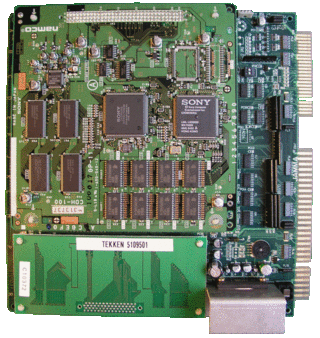Related Research Articles

The Atari 7800 ProSystem, or simply the Atari 7800, is a home video game console officially released by Atari Corporation in 1986 as the successor to both the Atari 2600 and Atari 5200. It can run almost all Atari 2600 cartridges, making it one of the first consoles with backward compatibility. It shipped with a different joystick than the 2600-standard CX40 and included Pole Position II as the pack-in game. The European model has a gamepad instead of a joystick. Most of the early releases for the system are ports of 1981–1983 arcade video games. The final wave of 7800 cartridges are closer in style to what was available on other late 1980s consoles, such as Scrapyard Dog and Midnight Mutants.

The Game Boy Color is an 8-bit handheld game console, manufactured by Nintendo, which was released in Japan on October 21, 1998, and to international markets that November. Compared to the original Game Boy, the Game Boy Color features a color TFT screen rather than monochrome, a processor that can operate twice as fast, and four times as much memory. It retains backward compatibility with games initially developed for its predecessor.

The Neo Geo, stylized as NEO•GEO and also written as NEOGEO, is a ROM cartridge-based video gaming system released on April 26, 1990, by Japanese game company SNK Corporation. Designed as both an arcade system board and home video game console, the Neo Geo was marketed as the first 24-bit system; its CPU is actually a 16/32-bit 68000 with an 8-bit Z80 coprocessor, while its GPU chipset has a 24-bit graphics data bus. It was a very powerful system when released, more powerful than any video game console at the time, and many arcade systems such as rival Capcom's CPS, which did not surpass it until the CP System II in 1993. Neo Geo hardware production lasted seven years; it was succeeded by Hyper Neo Geo 64.

The TurboGrafx-16, known as the PC Engine outside North America, is a home video game console designed by Hudson Soft and sold by NEC Home Electronics. It was the first console marketed in the fourth generation, commonly known as the 16-bit era, however in actuality, the console has an 8-bit central processing unit (CPU) coupled with a 16-bit graphics processor, effectively making the claim somewhat false advertising. It was released in Japan in 1987 and in North America in 1989. In Europe the Japanese model was unofficially imported and distributed in the United Kingdom and France from 1988. In Japan, the system was launched as a competitor to the Famicom, but the delayed United States release meant that it ended up competing with the Sega Genesis and later the Super NES.

Parallax scrolling is a technique in computer graphics where background images move past the camera more slowly than foreground images, creating an illusion of depth in a 2D scene of distance. The technique grew out of the multiplane camera technique used in traditional animation since the 1930s.

A ROM image, or ROM file, is a computer file which contains a copy of the data from a read-only memory chip, often from a video game cartridge, or used to contain a computer's firmware, or from an arcade game's main board. The term is frequently used in the context of emulation, whereby older games or firmware are copied to ROM files on modern computers and can, using a piece of software known as an emulator, be run on a different device than which they were designed for. ROM burners are used to copy ROM images to hardware, such as ROM cartridges, or ROM chips, for debugging and QA testing.

The X68000 is a home computer created by Sharp Corporation. It was first released in 1987 and sold only in Japan.

The Hyper Neo Geo 64 is an arcade system board created by SNK, and released in September 1997. As the successor of the popular Neo Geo (MVS), it was the first and only SNK hardware set capable of rendering in 3D, conceived to bring SNK into the 3D era that had arisen during the mid-1990s.

The CP System, also known as Capcom Play System, CPS for short, and retroactively as CPS-1, is an arcade system board developed by Capcom that ran game software stored on removable daughterboards. More than two dozen arcade titles were released for CPS-1, before Capcom shifted game development over to its successor, the CP System II. Technical support for the CPS-1 ended on March 31, 2015.

Multi-memory controllers or memory management controllers (MMC) are different kinds of special chips designed by various video game developers for use in Nintendo Entertainment System (NES) cartridges. These chips extend the capabilities of the original console and make it possible to create NES games with features the original console cannot offer alone. The basic NES hardware supports only 40KB of ROM total, up to 32KB PRG and 8KB CHR, thus only a single tile and sprite table are possible. This limit was rapidly reached within the Famicom's first two years on the market and game developers began requesting a way to expand the console's capabilities.

The Namco System 11 is a 32-bit arcade system board developed jointly by Namco and Sony Computer Entertainment. Released in 1994, the System 11 is based on a prototype of the PlayStation, Sony's first home video game console, using a 512 KB operating system and several custom processors. The Namco System 12 is an upgraded version of the System 11 that was released in 1996, featuring faster processing power.
PGM may refer to:

DoDonPachi II: Bee Storm is a vertically scrolling bullet hell shoot 'em up developed by International Games System (IGS) and published by Capcom in 2001. It is the only entry in the DonPachi series to not be developed by Cave.

Martial Masters is an arcade fighting game developed by International Game System (IGS) of Taiwan and originally released in 1999 on their PolyGame Master arcade board. The game was released in Japan in 2000 as Shin-Ī Ken (シンイーケン), and was brought over to the United States by Andamiro in 2001 as Martial Masters. The setting and characters draw inspiration from Hong Kong martial arts films. It was not ported to other platforms until 2023 when it was released as part of IGS Classic Arcade Collection on Nintendo Switch.
Demon Front is a side-scrolling run and gun arcade game released in 2002 by International Games System. It shares many characteristics with the Metal Slug series.

Knights of Valour is a side-scrolling beat 'em up video game series released by International Games System (IGS). The plot is loosely adapted from the 14th century Chinese historical novel Romance of the Three Kingdoms by Luo Guanzhong, and features the Five Tiger Generals, Zhuge Liang, Diaochan and others as playable characters. The gameplay involves the use of magical powers that are not featured in other games also based on the novel.

A video game console emulator is a type of emulator that allows a computing device to emulate a video game console's hardware and play its games on the emulating platform. More often than not, emulators carry additional features that surpass limitations of the original hardware, such as broader controller compatibility, timescale control, easier access to memory modifications, and unlocking of gameplay features. Emulators are also a useful tool in the development process of homebrew demos and the creation of new games for older, discontinued, or rare consoles.

The Nintendo Entertainment System (NES) is an 8-bit home video game console produced by Nintendo. It was first released in Japan on July 15, 1983, as the Family Computer (Famicom). It was released in US test markets as the redesigned NES in October 1985, and fully launched in the US the following year. The NES was distributed in Europe, Australia, and parts of Asia throughout the 1980s under various names. As a third-generation console, it mainly competed with Sega's Master System.

ESP Ra.De. is a 1998 vertical-scrolling bullet hell arcade game originally developed by Cave and co-published by Atlus and Nihon System in Japan. Set in the year 2018, players assume the role from one of the three ESPers to overthrow Lady Garra and her Yaska syndicate from taking over Tokyo.
References
- ↑ "PolyGame Master Specification". Wiki Arcadeotaku.
- ↑ "IGS Classic Arcade Collection". Nintendo . Retrieved 2023-10-23.
- ↑ "PolyGame Master 2 Specification". Wiki Arcadeotaku.
- ↑ "PGM 3".
- ↑ "PGM 3".
- ↑ "PGM 3".
- ↑ "PGM 3".
- ↑ "Dragon World 3 marquee". Archived from the original on 2020-03-08. Retrieved 2020-03-08.
- ↑ "Martial Masters arcade brochure" . Retrieved 2020-03-08.
- ↑ Nippon Ichi And Disgaea Coming To An Arcade Near You